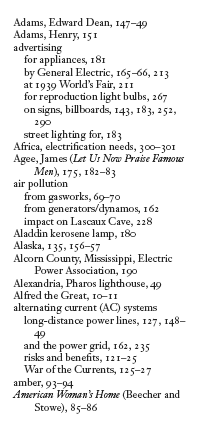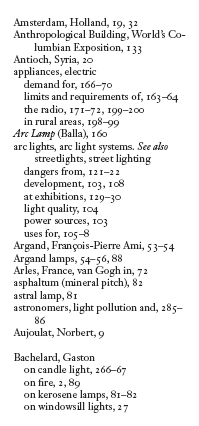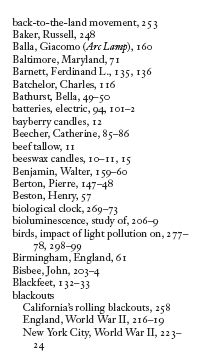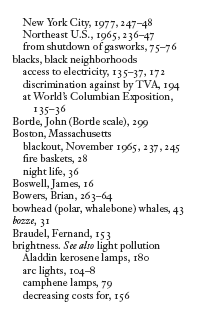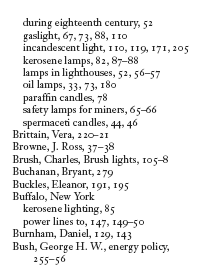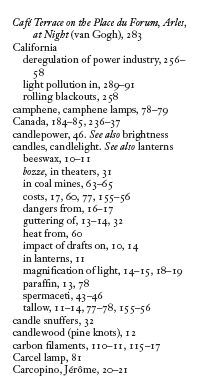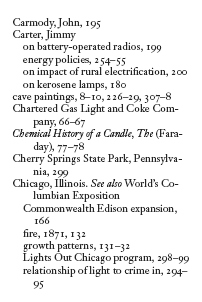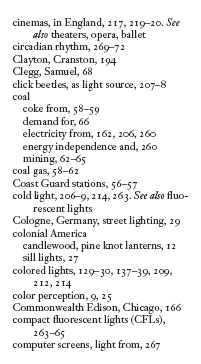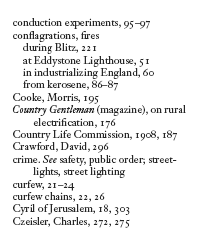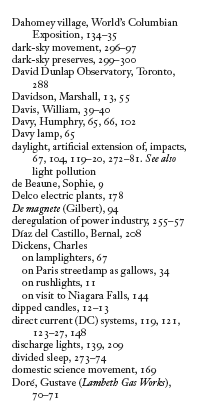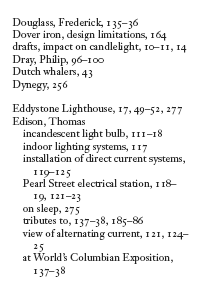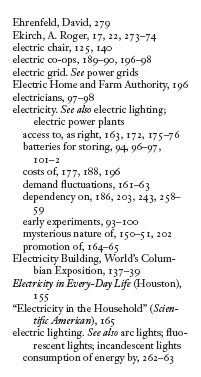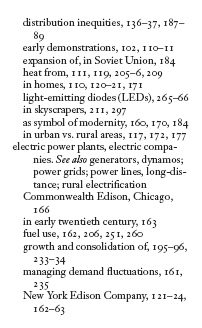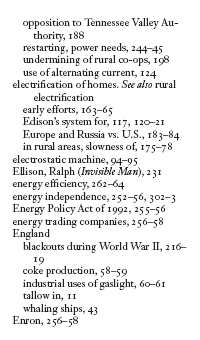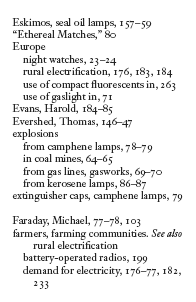Brilliant (41 page)
Authors: Jane Brox

271Â "I emerged": Michel Siffre, "Six Months Alone in a Cave,"
National Geographic,
March 1975, p. 428.
"Forty-second awakening": Siffre,
Beyond Time,
pp. 166, 181â82. "I underestimated": Ibid., pp. 222, 225.
[>]
 "meaning that most": Warren E. Leary, "Feeling Tired and Run Down? It Could Be the Lights,"
New York Times,
February 8, 1996,
http://www.nytimes.com
(accessed August 9, 2007).
"Every time we turn on": Dr. Charles Czeisler, quoted ibid.
[>]
 Divided sleep: See A. Roger Ekirch, "Sleep We Have Lost: Preindustrial Slumber in the British Isles,"
American Historical Review
106, no. 2 (April 2001),
http://www.historycooperative.org/journals/ahr/106.2/ahooo343.html
(accessed July 4, 2007).
[>]
 "There is one stirring": Robert Louis Stevenson, "A Night Among the Pines," in "
Travels with a Donkey in the Cévennes" and "The Amateur Emigrant
" (London: Penguin Books, 2004), pp. 56â57.
"slept only about an hour": Natalie Angier, "Modern Life Suppresses an Ancient Body Rhythm,"
New York Times,
March 14, 1995,
http://www.nytimes.com
(accessed August 9, 2007).
[>]
 "We think Thomas Edison": Czeisler, quoted in Leary, "Feeling Tired and Run Down?"
"Everything which decreases": "Edison's Prophesy: A Duplex, Sleepless, Dinnerless World,"
Literary Digest,
November 14, 1914, p. 966.
[>]
 "Offshore hydrocarbon platforms": William A. Montevecchi, "Influences of Artificial Light on Marine Birds," in
Ecological Consequences of Artificial Night Lighting,
ed. Catherine Rich and Travis Longcore (Washington, DC: Island Press, 2006), p. 100.
"Many nocturnal species": Paul Beier, "Effects of Artificial Night Lighting on Terrestrial Mammals," in
Ecological Consequences of Artificial Night Lighting,
pp. 32â33.
[>]
 "exploring new habitat": Ibid., p. 34.
[>]
 "on misty and foggy": Sidney A. Gauthreaux Jr. and Carroll G. Belser, "Effects of Artificial Night Lighting on Migrating Birds," in
Ecological Consequences of Artificial Night Lighting,
p. 77.
"The habit of feeding": Jens Rydell, "Bats and Their Insect Prey at Streetlights," in
Ecological Consequences of Artificial Night Lighting,
p. 43.
[>]
 "humans are changing": Bryant W. Buchanan, "Observed and Potential Effects of Artificial Lighting on Anuran Amphibians," in
Ecological Consequences of Artificial Night Lighting,
p. 215. "as they have fallen": David Ehrenfeld, "Night, Tortuguero," in
Ecological Consequences of Artificial Night Lighting,
p. 138.
281Â "A light break": Winslow R. Briggs, "Physiology of Plant Responses to Artificial Lighting," in
Ecological Consequences of Artificial Night Lighting,
p. 401.
"the thousands of little": Michael Pollak, "'Towers of Light' Awe,"
New York Times,
October 10, 2004,
http://www.nytimes.com
(accessed October 13, 2008).
"Some people thought": Ibid.
C
HAPTER
20: M
ORE
I
S
L
ESS
[>]
 "At the second match": Robert Louis Stevenson, "Upper Gévaudan," in "
Travels with a Donkey in the Cévennes" and "The Amateur Emigrant
" (London: Penguin Books, 2004), p. 30.
"One night I went": Vincent van Gogh to Theo van Gogh, letter 499, in
The Complete Letters of Vincent van Gogh,
vol. 2 (Greenwich, CT: New York Graphic Society, 1959), p. 589.
[>]
 "has overpopulated": Charles Whitney, "The Skies of Vincent van Gogh,"
Art History
9, no. 3 (September 1986): 353.
"
I should be desperate":
Vincent van Gogh to Theo van Gogh, letter 418, in
The Complete Letters of Vincent Van Gogh,
vol. 2, p. 401.
[>]
 "brilliant with its own": Ovid,
Metamorphoses,
quoted in Bart J. Bok and Priscilla F. Bok,
The Milky Way
(Cambridge, MA: Harvard University Press, 1981), p. 1.
"emergency organizations": Terence Dickinson,
NightWatch: A Practical Guide to Viewing the Universe
(Buffalo, NY: Firefly Books, 1998), p. 47.
[>]
 "About one-tenth": P. Cinzano, F. Falchi, and C. D. Elvidge,
The First World Atlas of the Artificial Night Sky Brightness,
abstract, p. 1,
http://www.inquinamentoluminoso.it/cinzano/download/0108052.pdf
(accessed June 8, 2009).
"Surely it is": Galileo Galilei,
The Starry Messenger,
p. 1,
http://www.bard.edu/admission/forms/pdfs/galileo.pdf
(accessed June 8, 2009).
"Here we have": Ibid., p. 14.
"is not robed": Ibid., p. 1.
286 "With the aid": Ibid., p. 10.
"Many astronomers thought": Ronald Florence,
The Perfect Machine: Building the Palomar Telescope
(New York: HarperCollins, 1994), p. 106.
[>]
 "The 200-inch": Edwin Hubble, quoted ibid., p. 395.
"Astronomy is an incremental": Florence,
The Perfect Machine,
p. 404.
"It's like I'm looking": Quoted in Mari N. Jensen, "Light Pollution in Tucson,"
Tucson Citizen,
August 21, 2001,
http://www-kpno.kpno.noao.edu/pics/lighting/tucsoncitizen_8_21_01light.html
(accessed October 14, 2008).
[>]
 "When you take": Dave Kornreich, "How Does Light Pollution Affect Astronomers?"
Curious About Astronomy?âAsk an Astronomer,
April 1999, p. 1,
http://curious.astro.cornell.edu/question.php?number=194
(accessed September 18, 2007).
[>]
 "Light traversing a path": Bob Mizon,
Light Pollution: Responses and Remedies
(London: Springer-Verlag, 2002), p. 34.
"the city lights": Kornreich, "How Does Light Pollution Affect Astronomers?" p. 2.
[>]
 "is equivalent to": Richard Preston,
First Light: The Search for the Edge of the Universe
(New York: Atlantic Monthly Press, 1987), p. 24.
[>]
 "Then Humankind was born": Ovid,
Metamorphoses,
trans. A. S. Kline, 1.68â88,
http://etext.virginia.edu/latin/ovid/trans/Metamorph.htm
(accessed June 29, 2009).
C
HAPTER
21: T
HE
O
NCE AND
F
UTURE
L
IGHT
[>]
 "The spiritual instant": Henri Focillon,
The Life of Forms in Art,
trans. Charles Beecher Hogan and George Kubler (New York: Zone Books, 1992), p. 152.
[>]
 "The
Home Office":
Bob Mizon,
Light Pollution: Responses and Remedies
(London: Springer-Verlag, 2002), p. 61.
"a car storage area": Ibid.
How complex the relation: For information on the study of Chicago's alleyways, see
The Chicago Alley Lighting Project: Final Evaluation Report,
April 2000,
http://www.icjia.state.il.us//files/20/57/02/f205702/public/pdf/ResearchReports
(accessed June 8, 2009).
295Â "Yes, my tent became": Michel Siffre,
Beyond Time: The Heroic Adventure of a Scientist's 63 Days Spent in Darkness and Solitude in a Cave 375 Feet Underground,
ed. and trans. Herma Briffault (London: Chatto & Windus, 1965), pp. 99â100.
[>]
 "A growing number": "Sustainability, Urban Planning, and What They Mean to Dark Skies,"
Newsletter of the International Dark-Sky Association,
http://www.darksky.org/news/newsletters/60-69/nl66_fea.html
(accessed May 23, 2007).
[>]
 "a new city of light": Hollister Noble, "New York's Crown of Light,"
New York Times,
February 8, 1925, p. SM2.
[>]
 "The tall tower": Ken Belson, "Efficiency's Mark: City Glitters a Little Less,"
New York Times,
November 2, 2008,
http://www.nytimes.com
(accessed March 11, 2009).
[>]
 "Unfortunately most of today's": John E. Bortle, "Introducing the Bortle Dark-Sky Scale,"
Sky & Telescope,
February 2001, p. 126.
[>]
 "There's a good part": Quoted in Dave Caldwell, "Dark Sky, Bright Lights,"
New York Times,
September 14, 2007, p. F10.
[>]
 "When my mother": Alhassan Sillah, "Fuel for Thought in Guinea,"
BBC News,
http://newsvote.bbc.co.uk/mpapps/pagetools/print/news.bbc.co.uk/2/h
(accessed March 14, 2009).
"I hardly ever": Ibid.
"I used to study": Rukmini Callimachi, "Kids in Guinea Study Under Airport Lamps,"
Washington Post,
http://www.washingtonpost.com/wp-dyn/content/article/2007/07/19
(accessed March 14, 2009).
[>]
 "Working in the so-called": Sheila Kennedy, quoted in "Light unto the Developing World,"
Miller-McCune Magazine,
http://www.miller-mccune.com/article/light-unto-the-developing-world
(accessed December 13, 2008).
"Instead of a centralized": Kennedy, quoted in "Energizing the Household Curtain," JumpIntoTomorrow.com,
http://www.jumpintotomorrow.com/template/index/php?tech=82
(accessed December 14, 2008).
E
PILOGUE
[>]
For further information on ways to reduce light pollution, see International Dark-Sky Association,
http://www.darksky.org
, and Fatal Light Awareness Program (FLAP),
http://www.flap.org
.
